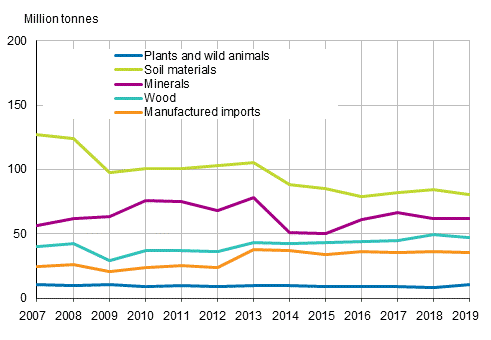Published: 3 December 2020
Domestic material consumption fell by three per cent from the previous year
Altogether 178 million tonnes of natural resources were taken into use in Finland in 2019. The figure was the lowest in the 2010s, over a sixth lower than in 2013 when the figure was at its highest. Compared to the level of 2017 to 2018, the fall was considerably smaller, good one per cent.
Domestic material consumption 2007 to 2019
| Million tonnes | 2007 | 2008 | 2009 | 2010 | 2011 | 2012 | 2013 | 2014 | 2015 | 2016 | 2017 | 2018 | 2019 |
| Domestic direct inputs | 195 | 196 | 169 | 187 | 186 | 185 | 215 | 170 | 167 | 172 | 180 | 180 | 178 |
| Foreign direct inputs | 64 | 69 | 53 | 60 | 62 | 56 | 59 | 58 | 54 | 57 | 57 | 60 | 57 |
| Exports | 44 | 42 | 35 | 43 | 45 | 44 | 45 | 45 | 42 | 44 | 45 | 49 | 51 |
| Domestic material consumption | 215 | 223 | 187 | 204 | 203 | 197 | 229 | 183 | 179 | 186 | 191 | 191 | 185 |
Domestic material consumption, one indicator of sustainable development, was three per cent lower in 2019 than in 2017 to 2018. The fall was mainly due to decreased direct domestic inputs and imports, as well as a slight growth in exports. The fall was mostly due to a decrease of good five per cent in soil extraction. Indicators for sustainable development .
Use of direct inputs by material group 2007 to 2019, million tonnes

Domestic material consumption is calculated by adding imports to domestic direct inputs (introduced natural resources) and by subtracting exports. Of the natural resources introduced in 2019, altogether 28 per cent were wood and other plants, 28 per cent mineral ores and 42 per cent soil materials. In imports most weight was laid on crude oil, 30 per cent and timber, 17 per cent of the total weight of imports. Of the weight of exports, oil refined products and forest industry products had the biggest shares.
Total material requirement amounted to good 600 million tonnes in 2019, which is also over five per cent lower than in the year before. In addition to domestic direct inputs and imports, total material requirement includes unused extraction related to forestry and the extractive industry, as well as hidden flows from imports. The decrease in total material requirement was particularly caused by the decrease in ore and soil extraction, the related unused extraction, and the imports of metals and metal products and their hidden flows.
Source: Economy-wide material flow accounts 2019, Statistics Finland
Inquiries: Niina Lesonen 029 551 3406, environmental.accounts@stat.fi
Head of Department in charge: Mari Ylä-Jarkko
Publication in pdf-format (209.0 kB)
- Tables
-
Tables in databases
Pick the data you need into tables, view the data as graphs, or download the data for your use.
Appendix tables
Updated 3.12.2020
Official Statistics of Finland (OSF):
Economy-wide material flow accounts [e-publication].
ISSN=2242-1289. 2019. Helsinki: Statistics Finland [referred: 20.4.2025].
Access method: http://stat.fi/til/kanma/2019/kanma_2019_2020-12-03_tie_001_en.html

